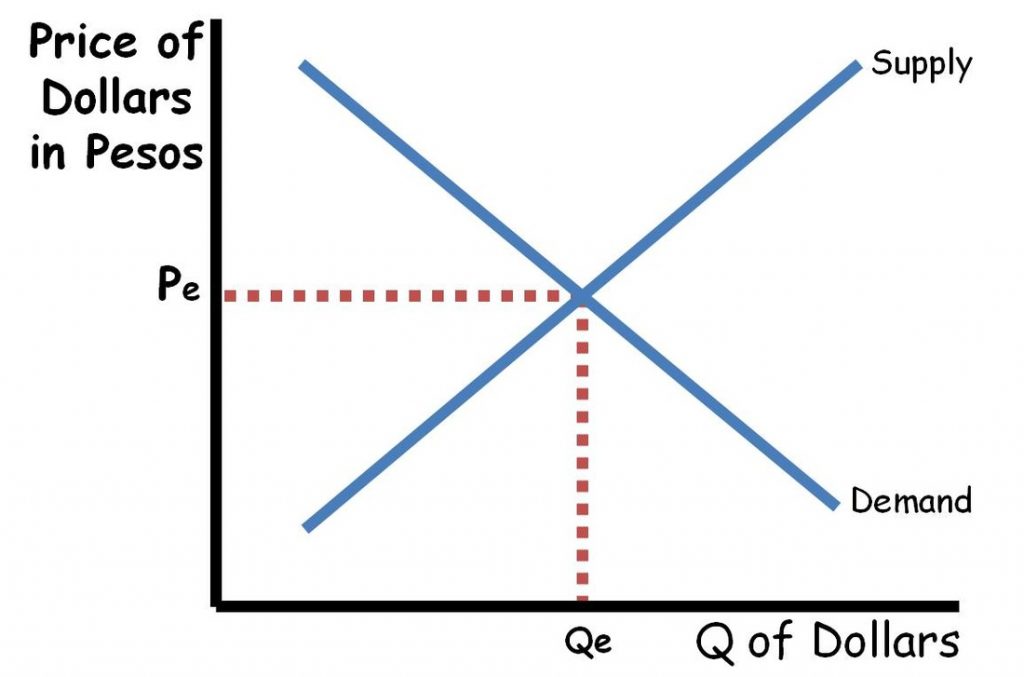In the ever-evolving realm of international finance, the currency that dominates the foreign exchange market holds immense sway, shaping global trade, investment, and economic growth. This article delves into the fascinating world of currency dominance, exploring its significance, influencing factors, and historical evolution.
Currencies such as the US dollar, euro, and Japanese yen have long held dominant positions, but the dynamics of currency dominance are constantly shifting. This article analyzes the economic, political, and geopolitical forces that drive currency strength and examines the potential challenges and emerging trends that may reshape the future of the foreign exchange market.
Currency Dominance in the Foreign Exchange Market
Currency dominance refers to the disproportionate significance of certain currencies in the foreign exchange (forex) market. These currencies play a pivotal role in global trade, reserve accumulation, and investment decisions, shaping the dynamics of the forex market.
The US dollar (USD) has long held a dominant position in the forex market, accounting for approximately 60% of global currency transactions. This dominance stems from the US’s economic and political power, as well as the widespread use of the USD as a reserve currency by central banks worldwide.
Other Dominant Currencies
While the USD remains the most dominant currency, other currencies also play significant roles in the forex market. The euro (EUR), the Japanese yen (JPY), and the British pound (GBP) are among the most widely traded currencies, accounting for a combined share of over 20% of global transactions.
- The euro is the official currency of the eurozone, a group of 19 European countries. It is the second most traded currency in the world, after the USD.
- The Japanese yen is the currency of Japan, the world’s third-largest economy. It is a popular currency for carry trade, a strategy involving borrowing in one currency with a low interest rate and investing in another currency with a higher interest rate.
- The British pound is the currency of the United Kingdom. It is a major currency in the global financial markets and is often used as a reserve currency.
Factors Influencing Currency Dominance

The dominance of a currency in the foreign exchange market is influenced by a combination of economic, political, and geopolitical factors. These factors shape the relative strength and stability of a currency, making it more or less attractive to international investors and traders.
Economic Factors
Economic factors play a significant role in determining currency dominance. Some key economic indicators that contribute to a currency’s strength include:
- Gross Domestic Product (GDP): A country with a large and growing economy tends to have a stronger currency, as it indicates a healthy and productive economy that attracts foreign investment.
- Interest Rates: Higher interest rates can make a currency more attractive to investors, as they offer a higher return on investments. This can lead to increased demand for the currency, strengthening its value.
- Inflation: Low inflation rates can contribute to currency dominance, as they indicate a stable economy and protect the purchasing power of the currency. High inflation, on the other hand, can weaken a currency as it erodes its value over time.
Political and Geopolitical Factors
Political and geopolitical factors can also impact currency strength. Some key factors that influence currency dominance include:
- Political Stability: A politically stable country is more likely to have a strong currency, as investors are more confident in the stability of the government and the economy.
- Trade Agreements: Trade agreements between countries can boost the demand for a currency, especially if the country is a major exporter of goods or services. This can lead to increased demand for the currency, strengthening its value.
Impact of Currency Dominance

Currency dominance has significant implications for global markets and economies. It can provide advantages and disadvantages, impacting trade, investment, and economic growth.
Advantages of Currency Dominance, Currency that dominates the foreign exchange market
- Stability: A dominant currency serves as a stable reference point for international transactions, reducing exchange rate volatility and facilitating trade.
- Reduced Transaction Costs: Transactions involving the dominant currency incur lower costs due to its widespread acceptance and liquidity.
- Increased Investment: A dominant currency attracts foreign investment, as investors seek the stability and liquidity it offers.
Disadvantages of Currency Dominance
- Exchange Rate Risk: Countries that do not use the dominant currency may face exchange rate risk, leading to fluctuations in the value of their exports and imports.
- Inflationary Pressures: A dominant currency can lead to inflationary pressures in countries that peg their currencies to it.
- Reduced Economic Autonomy: Countries that adopt the dominant currency may surrender some economic autonomy, as their monetary policy decisions are influenced by the issuing country.
Impact on Global Trade and Investment
Currency dominance influences global trade by reducing transaction costs and exchange rate risks, making it easier for businesses to engage in international trade. It also attracts foreign investment, as investors seek the stability and liquidity of the dominant currency.
Remember to click foreign exchange market in kannada to understand more comprehensive aspects of the foreign exchange market in kannada topic.
Impact on Economic Growth
A dominant currency can contribute to economic growth by facilitating trade and investment. However, it can also lead to inflationary pressures and reduced economic autonomy, which can hinder economic growth in the long run.
Historical Evolution of Currency Dominance
The dominance of currencies in the foreign exchange market has witnessed significant shifts over time. These shifts have been influenced by various economic, political, and historical factors.
In the early 20th century, the British pound sterling held a dominant position in the global currency system, primarily due to the British Empire’s economic and political power.
Rise of the US Dollar
After World War II, the United States emerged as a global economic and political superpower, and the US dollar gradually replaced the pound sterling as the dominant currency.
The Bretton Woods Agreement in 1944 established the US dollar as the world’s reserve currency, pegged to gold. This agreement played a significant role in solidifying the US dollar’s dominance.
Challenges to US Dollar Dominance
In recent years, the US dollar’s dominance has faced challenges from other currencies, such as the euro and the Chinese renminbi.
Learn about more about the process of foreign exchange rate in pakistan open market today in the field.
The rise of the euro, a common currency for the European Union, has eroded the US dollar’s dominance in international trade and investment.
You also can understand valuable knowledge by exploring foreign exchange market ap macro graph.
Similarly, the growing economic power of China has led to increased use of the renminbi in international transactions, challenging the US dollar’s status as the primary reserve currency.
Factors Influencing Currency Dominance
The dominance of a currency is influenced by several factors, including:
- Economic strength of the issuing country
- Political stability and credibility
- Currency convertibility and liquidity
- Central bank policies and monetary stability
Future Trends in Currency Dominance
As the global economy continues to evolve, the dominance of existing currencies in the foreign exchange market may face challenges. Emerging markets are growing in economic power, and their currencies may gain prominence in the future. Additionally, technological advancements such as digital currencies and blockchain technology could disrupt the traditional currency landscape.
Potential Challenges to the Dominance of Existing Currencies
* Economic growth in emerging markets: As developing countries continue to grow economically, their currencies may become more attractive to investors and traders. This could lead to a decline in the dominance of traditional reserve currencies such as the US dollar and the euro.
* Political instability: Political instability in countries with major currencies can lead to a loss of confidence in those currencies. This could lead to investors and traders seeking alternative currencies for safe haven purposes.
* Technological advancements: The development of digital currencies and blockchain technology could disrupt the traditional currency system. These technologies have the potential to make cross-border payments more efficient and less expensive, which could reduce the demand for traditional currencies.
Emerging Currencies That May Gain Prominence in the Future
* Chinese yuan: The Chinese yuan is the currency of the world’s second-largest economy. As China’s economy continues to grow, the yuan is likely to become more widely used in international trade and investment.
* Indian rupee: The Indian rupee is the currency of India, a rapidly growing economy with a large population. The rupee is likely to become more important in the future as India’s economy continues to develop.
* Brazilian real: The Brazilian real is the currency of Brazil, a large and resource-rich country. The real is likely to become more important in the future as Brazil’s economy continues to grow and diversify.
Case Studies of Dominant Currencies
The US dollar and the euro are two of the most dominant currencies in the foreign exchange market, accounting for a significant portion of global currency transactions. These currencies have played a crucial role in international trade, investment, and financial markets for decades.
The dominance of these currencies can be attributed to a combination of economic, political, and historical factors. In this section, we will delve into the historical performance, economic factors, and geopolitical influences that have contributed to the dominance of the US dollar and the euro.
US Dollar
The US dollar has been the world’s dominant currency since the end of World War II. Its dominance is largely due to the strength of the US economy, which is the largest in the world. The US dollar is also widely used as a reserve currency by central banks around the world.
The US dollar has experienced periods of both strength and weakness over the years. In recent years, the dollar has strengthened against other major currencies, due in part to the Federal Reserve’s interest rate hikes.
Euro
The euro is the second most dominant currency in the world, and it is the official currency of the eurozone, which consists of 19 countries. The euro was introduced in 1999, and it has since become one of the most traded currencies in the world.
The euro’s dominance is due to the size and strength of the eurozone economy, which is the second largest in the world. The euro is also widely used as a reserve currency by central banks around the world.
The euro has experienced periods of both strength and weakness over the years. In recent years, the euro has weakened against the US dollar, due in part to the European Central Bank’s low interest rates.
Last Recap: Currency That Dominates The Foreign Exchange Market

Understanding currency dominance is crucial for businesses, investors, and policymakers alike. By recognizing the factors that influence currency strength and anticipating future trends, we can better navigate the complexities of the global financial landscape and make informed decisions that drive economic prosperity.
